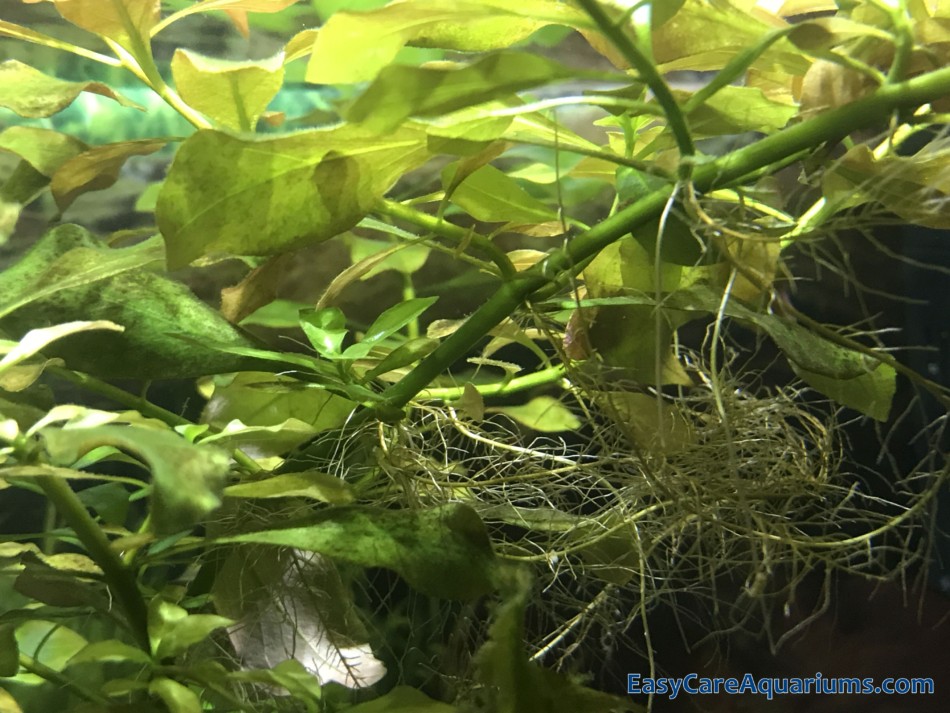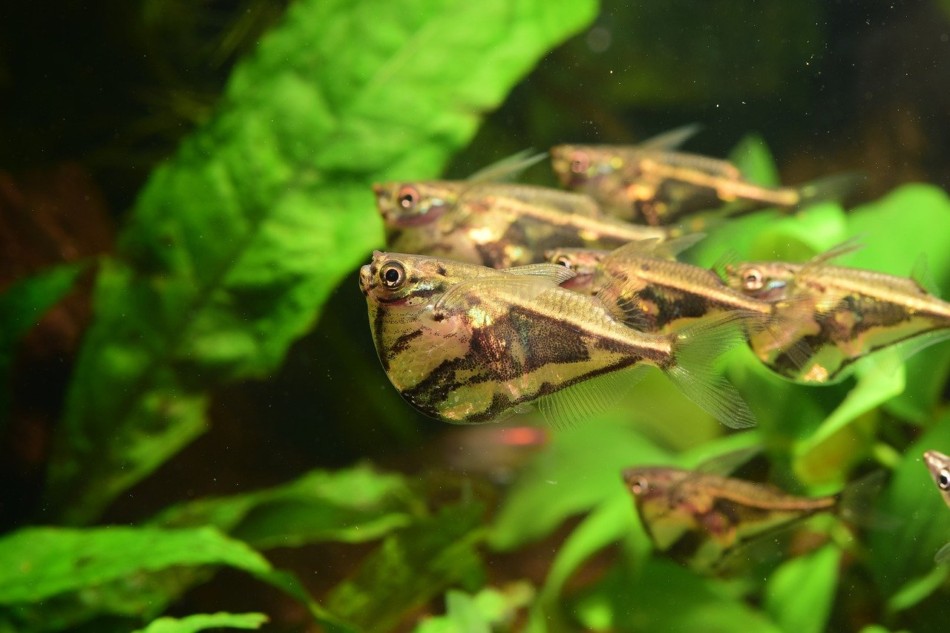This article may contain some affiliate links to products. The links provide me a small percentage of commission but do not cost you anything extra to use. (See full disclosure statement here ).
).
Hatchetfish are an egg scattering fish that are considered hard to breed. Although it’s not impossible to breed them. But that does depend on which type of Hatchetfish you’re keeping. And also on how much effort you’re willing to put in.
Hatchetfish scatter their eggs onto floating plants/roots that grow near the top of the water. Because they are egg scatterers it means that they fertilize their eggs externally. The female releases her eggs and the male then fertilizes them with his milt (semen). The fertilized eggs hatch and develop into Hatchetfish fry (babies).
If you’re interested in encouraging your Hatchetfish to breed keep reading for some useful information and tips.
Let’s take a closer look at how Hatchetfish breed and how to protect the fry
How Can I Tell If My Hatchetfish Is Male Or Female?
The first thing you need to know when it comes to breeding Hatchetfish is whether you’ve got both males and females in your tank. I know this sounds like and obvious statement but sexing these fish isn’t always easy.
It can be tricky, especially when your Hatchetfish are young. In fact, it can be difficult even when the fish are adults.
The general rule to sexing adult Hatchetfish is to look at them from the top of the tank.
So when viewed from above mature male and female Hatchetfish may look a little different
- Male Hatchetfish are generally a bit smaller and slimmer than the females.
- Female Hatchetfish are a little bit bigger than the males. They also have a more rounded abdomen than the males because they need room to carry the eggs.
The differences can be really difficult to see. This is why Hatchetfish are so difficult to sex.
If you want your Hatchetfish to breed, or you would just like both males and females in your tank to create a balance, it’s best to get a decent sized group of them.
Hatchetfish prefer to live in groups anyway. So whether you plan to breed them, or not, it’s always better to get at least 6 as a bare minimum. In fact, the more the merrier.
What Does Hatchetfish Breeding Behaviour Look Like?
When your Hatchetfish are ready to breed/mate you will notice a change in behaviour. Particularly from the males. The males will show more interest in the females and begin the spawning behaviour. You may also notice that your females are fatter than usual because they’re carrying eggs.
Hatchetfish Spawning Behaviour
During spawning a male Hatchetfish will go alongside a female. Then he will use his wing-like fins in a fluttering motion to encourage the female to release her eggs. This usually happens near, or amongst, leafy plants that are close the surface of the water. The female releases her eggs, which are sticky, onto the plants and floating plant roots. The male then fertilises the eggs with his milt (semen).
Hatchetfish spawning usually happens at dusk if the tank is lit by natural daylight changes. If you have a tank light then this can affect spawning. Although Hatchetfish have been know to spawn with a tank light on a ‘moonlight’ setting.
Hatchetfish Spawning Temperature
The optimal temperature for breeding Hatchetfish is around 28-30 Degrees Celsius (82-86 Degrees Fahrenheit). Although in the fish keeping hobby opinions vary. But the general consensus is that the breeding temperature is a little higher than the usual aquarium temperature. The reason for this is that warmer temperatures replicate the natural breeding season of the late spring/early summer in the Hatchetfish’s native habitat.
What Do Hatchetfish Eggs Look Like?
Hatchetfish eggs look like tiny little pearls. They are quite sticky and you may see them attached to plant leaves and the roots of floating plants. And, if you have a spawning mop in your aquarium, you will see the eggs attached to the wool strands.
How Many Eggs Do Hatchetfish Scatter At A Time?
Hatchetfish scatter several eggs at a time. How many eggs they scatter will depend on the individual fish and how many females are scattering their eggs around the same time. It can also depend on the particular species of Hatchetfish that you’re keeping. Although I don’t have a definitive answer to this question you’re likely to see a fair number of eggs after your Hatchetfish have spawned.
How Long Does It Take For Hatchetfish Eggs To Hatch?
Hatchetfish eggs take, on average, between 24-36 hours to hatch. Hatching time can depend on tank conditions and tank temperature. After the fry have hatched they don’t become free-swimming for around 4-5 days or so. During this time they feed off of their yolk sac. They don’t start eating other foods until their yolk sac has been used up and they are hungry.

Do Hatchetfish Eat Their Own Eggs And Fry (Babies)?
Hatchetfish are not known to eat their own eggs. That’s not to say that they won’t if they want to, or are really hungry. Their fry (babies) on the other hand are a different matter. Hatchetfish will eat their fry as soon as they hatch. Hatchetfish are not parental in any way. So any small fry that they find they will eat. Even if they are their own.
Saving Hatchetfish Fry
Breeding Hatchetfish is extremely difficult. And some varieties are more difficult to breed in an aquarium than others. For example, Marbled Hatchetfish are considered easier to breed than the Silver Hatchetfish. However, if you would like to try to breed your Hatchetfish you can give it a shot.
One way, and maybe the best way, is to set up a separate, cycled breeding/nursery tank. The tank will need to have tall or floating plants. You could also use a spawning mop (article link).
(article link).
Once your Hatchetfish have spawned in the tank you will need to remove the adults and put them back into their original tank. After that you just let any fertilised eggs hatch and develop into Hatchetfish fry.
You can just let nature take its course in the main tank. However, you will need to provide plenty of plants/spawning mops for the fry to hide in without covering too much of the water surface.
It’s also worth bearing in mind that if your Hatchetfish live in a community tank the eggs/fry will also be at risk of being eaten by the other fish too.
If you would like more information about what to feed your Hatchetfish, both the adults and the fry (babies), read my article ‘What Do Hatchetfish Eat? ‘.
‘.
Other Frequently Asked Questions
How Big Do Hatchetfish Get?
Hatchetfish can grow to between 1-3 inches (2.54-7.62 cm) in length at adult size depending on species. So when you’re trying to work out how many Hatchetfish you can keep in your aquarium you’ll need to check how big your Hatchetfish will get.
How Long Do Hatchetfish Live For?
Hatchetfish can live up to 5 years when kept in an aquarium. It’s possible for them to live longer but you may also find that some of them live shorter lives. Their lifespan will depend on the individual fish and can also depend on their tank conditions and care.
Are Hatchetfish Hardy?
In general, Hatchetfish are considered to be fairly hardy. However, they are best kept by aquarists that have at least a little fish keeping experience. It’s also worth mentioning that Hatchetfish are prone to Ich (White Spot) when stressed. So taking your time to acclimate them to their new home is important.
What’s The Male To Female Ratio For Hatchetfish?
Because Hatchetfish are difficult to sex trying to get a male to female ratio in your tank is going to be really hard to do. The main thing here is to have a decent sized group of them to give you a better chance of having both sexes. A bare minimum of 6 is recommended. Hatchetfish do better living in a group no matter what sex they are.
Are Hatchetfish Aggressive?
Hatchetfish are not generally considered to be aggressive. Although some species of Hatchetfish can be more territorial than others they are usually a non-aggressive fish. In fact they are considered a peaceful community fish.
How Do Hatchetfish Protect Themselves?
To avoid predators Hatchetfish use their scales to diffuse light which has the effect of making them almost invisible. They also have the ability to emit a pale blue light from their bellies that mimics daylight coming in from above the water. So for Hatchetfish it’s more about camouflage and evasion rather than physical defence.
Can Hatchetfish Fly?
Hatchetfish are often called a flying fish. This is because they can jump out of the water using their strong pectoral muscles. Then they glide through the air for a short distance using their wing-like fins, usually close to the surface of the water. They may do this on their own but it’s more usual for them to fly as a school of fish. The reasons for a Hatchetfish flight is either to avoid predators, or to catch and eat insects that are hovering close to the water’s surface.

